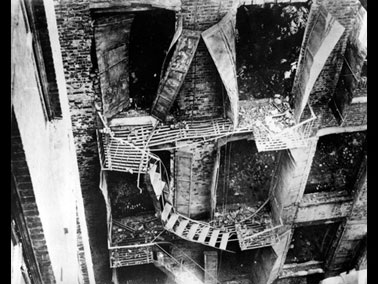FOR IMMEDIATE RELEASE
New York Press Office: (212) 346-5500; media@iii.org
NEW YORK, March 25, 2014 — The Triangle Shirtwaist Fire—a blaze fed by bundles of tissue paper and textile scraps, and that consumed the lives of 146 workers—roared through three floors of a high-rise building in New York City on this date in 1911. The tragedy however was also a watershed event that helped to usher in new standards for workplace safety, according to the
Insurance Information Institute (I.I.I.).
Recognizing the importance of fire safety, insurers today regularly have loss control engineering units inspect policyholder workplaces to evaluate the fire protection features of the buildings. In addition, the U.S. has made great strides in constructing more fire resistant buildings and upgrading building codes, thereby reducing the incidence of fires and improving fire suppression techniques.
“The dramatic changes in the way insurers assess risk is worth acknowledging as Americans reflect on what the high-rise workplace looked like on March 25, 1911, the day 146 people tragically died in New York City because of an out-of-control fire at the Triangle Waist Company,” said Michael Barry, vice president, Media Relations, I.I.I.
“Property and casualty insurers in 2014, unlike the few P/C insurers who were operating in 1911, focus constantly on life safety, fire prevention, and having their policyholders maintain important fire protection features, especially in buildings where an occupied floor is 75 feet above the fire department’s access level,” Barry added.
Moreover, insurers today allocate substantial resources to verify the adequacy of a building’s fire barriers and fire protection systems, as well as the commercial policyholder’s employee training and fire prevention programs. Insurers also look more intently at a building’s exit arrangements, something that was rarely considered in the early part of the 20th century. Policyholders who proactively reduce their risks generally enjoy lower premium rates.
Prior to March 1911, firewalls, fire doors, fire stairs and automatic sprinklers were available to New York City factory owners. Yet neither insurers nor the government insisted on their inclusion in the workplace. Since then, the installation of automatic sprinkler systems in high-rise buildings has become commonplace, as have mandatory fire drills and workplace doors that swing outward and remain unlocked during the work day.
State governmental workplace safety initiatives, many of which were launched soon after the events of 1911, were supplemented on the federal level in the early 1970s with the creation of the Occupational Health & Safety Administration (OSHA). Today insurers that cover high-rise buildings generally make sure their policyholders have in place such equipment and practices as: Automatic fire sprinkler systems; mandatory fire drills; smoke detectors and smoke alarms; and proper storage and handling of inflammable materials.
“The anniversary of the Triangle Fire offers a grim reminder to insurers and governmental regulators of what can happen when complacency sets in,” Barry concluded. “Insurers, policyholders and public policy makers must continue to implement sound risk management practices to ensure such tragedies are not repeated.”
RELATED LINKS
THE I.I.I. IS A NONPROFIT, COMMUNICATIONS ORGANIZATION SUPPORTED BY THE INSURANCE INDUSTRY
Insurance Information Institute, 110 William Street, New York, NY 10038; (212) 346-5500; www.iii.org
